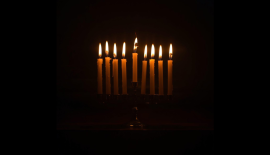Tzitzit – Signs of the Faith
In this series, ‘Signs of Faith’, objects, procedures and concepts that express Jewish faith are explained and discussed.
Every pious Jewish man always wears them as a visible sign of faith: the tzitzit. Those are the tassels spoken of in Numbers 15:38: “Speak to the Israelites and tell them to make tassels at the corners of their clothes for themselves, all their generations.” This is further specified in Deuteronomy 22:12, albeit with a different word in Hebrew: “At the four corners of the outer garment in which you cover yourselves, you must make tassels for yourselves.” The tallit, today’s prayer shawl, goes back to this rectangular upper garment.
What is the purpose of the tzitzit? Every time you look at it, you will think of God’s commandments and do them (Numbers 15:39). This is how Israel is reminded to be holy before God. Two notable places in the Bible where we should think of the tzitzit are Zechariah 8:23 and Matthew 9:20: the bleeding woman touches the tzitzit of Jesus.
‘You will have these tassels to look at and so you will remember all the commands of the Lord’
Numbers 15:39a
The tzitzit consists of four threads, three short ones and one long one. The long one is called the shammash, the ‘servant’. This was originally a blue-purple thread (Numbers 15:38). Over time, people had lost track of exactly which snail this colour was extracted from. Therefore, since the second century, four white threads have usually been used.
There are different ways of knotting the tzitzit, but the basics are the same. The four threads are inserted through an eye in the corner of the garment so that there is an equally long strand on both sides, two times four threads. Only the shammash is a lot longer on one side. Then a double knot is tied with the two strands. Then the long end of the shammash is wound around both strands several times, after which another double knot is tied. This is repeated three more times. The numerical value of five knots, eight threads, and the word tzitzit (600) is 613: the total of all the commandments and prohibitions that Israel must remember (Numbers 15:38).
The Ashkenazi tradition is to put seven windings first, then eight, then 11 and finally 13. In the Sephardic tradition, the shammash is first wrapped around it ten, then five, then six and finally five more times. This is the numerical value of the letters Y-H- W-H, the ineffable Name of God. Yemenite Jews have a very distinctive way of knotting, borrowed from Maimonides.





